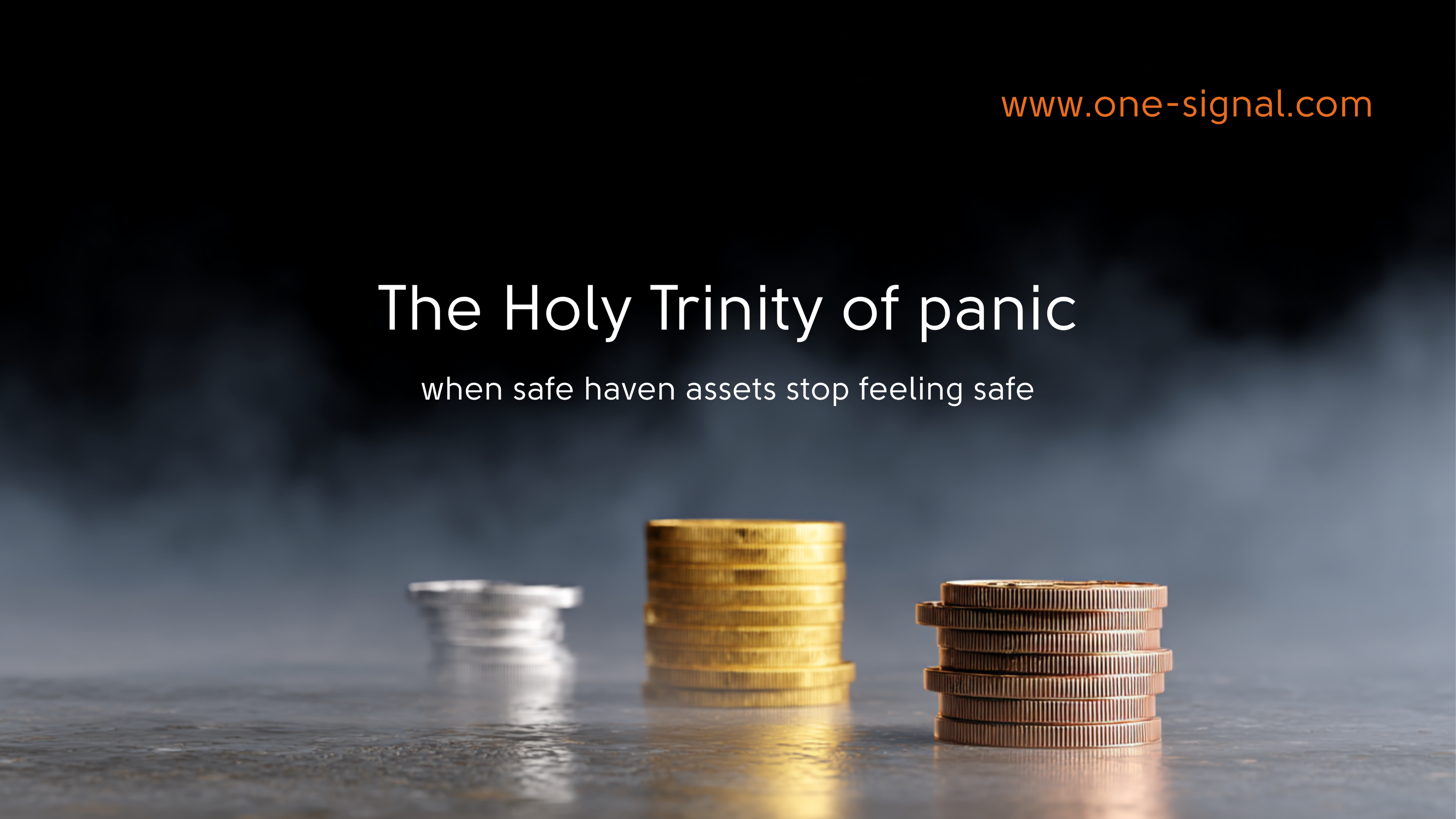
When gold, silver and Bitcoin start moving upwards in unison, you shouldn’t be celebrating for too long. History doesn’t repeat perfectly, but it rhymes loudly enough to recognize the pattern: when safe havens rise together, faith in the system is quietly fading.
The pattern we shouldn’t be ignoring
Each of these assets plays its own role in the market’s orchestra.
- Gold: the eternal store of value.
- Silver: the bridge between monetary and industrial worlds.
- Bitcoin: the digital rebellion against them both.
When all three rise together, it isn’t a coincidence. It’s a collective vote of no confidence. Investors, big and small, start moving capital into anything real, anything outside the grasp of central banks, regulators, or politicians.
And this movement tends to happen not in bull markets, but in late-cycle euphoria — right before the fall.
A look back through history
1979–1980:
Inflation hit 14%. Oil prices quadrupled. Gold soared from $200 to $850 an ounce — a 325% increase in less than two years. Silver went parabolic, jumping from $5 to $49 before collapsing. Within months, Volcker hiked rates to 20%. The system survived — barely.
2007–2008:
Gold climbed 30% as the banking sector cracked. Silver doubled. Meanwhile, the idea of Bitcoin was born — the first block mined in early 2009, right after the collapse of Lehman Brothers. The message in its code was no accident: “Chancellor on brink of second bailout for banks.”
2020:
COVID lockdowns froze the world. Gold broke above $2,000 for the first time. Silver doubled from $12 to $26. Bitcoin soared from $5,000 to $69,000 -a 1,280% gain. That rally wasn’t optimism — it was escaping velocity. Trillions of dollars were printed. Inflation, which had been “dead,” returned from the grave.
2023–2025:
Here we are again. Global debt has surpassed $313 trillion, nearly 3.5x global GDP. US interest payments alone now exceed $1 trillion annually — more than defence spending.
Gold has hovered near record highs above $2,500, silver trades near $32, and Bitcoin is once again approaching the $90,000 mark.
Different decade, same melody.
The thread
The details change, but the rhythm doesn’t.
Every time investors lose trust in paper wealth, they turn to what can’t be printed.
In the 1970s, it was inflation.
In 2008, it was leverage.
In 2020, it was liquidity.
Today, it’s debt — more of it than ever before.
The world’s sovereign debt pile has surpassed $300 trillion. The US alone adds roughly $1 trillion every 100 days. The “risk-free” rate has become a paradox — safe in name, but increasingly unsustainable in reality.
And so the same pattern reemerges capital runs to safety, and safety now wears a different face.
What the trio is telling us
When gold rises, it whispers inflation.
When silver rises, it shouts liquidity distortion.
When Bitcoin rises with them, it screams distrust.
It’s the market’s unspoken way of saying: we’ve had enough.
Enough of hidden bailouts. Enough of manipulated rates. Enough of calling instability “policy.”
These three don’t need to coordinate, they just react to the same pressure. Together, they form what could be called the collapse chorus: a symphony of assets that thrive when the system starts to unravel.
How we see it at ONE-SIGNALAt ONE-SIGNAL, we’ve tracked these macro correlations for years — across assets, sentiment, and time.
Between 2010 and 2023, our data-driven models generated a 39.4% cumulative return, compared to 11.9% for the S&P 500. Not because we predict collapses, but because we recognize the psychology behind them.
Markets don’t break out of nowhere, they erode slowly, through behavior. The same fear that pushes investors into gold and Bitcoin shows up in price action, volatility, and cross-asset sentiment long before headlines catch up.
That’s why we built ONE-SIGNAL: to help investors see through the noise, identify these inflection points early, and act on signals before the market starts shouting.
When others see panic, we see patterns.
The calm before the crack
No one can time it. Not the traders, not the economists, maybe the algorithms.
But the pattern is there:
- 1980: metals peak, recession follows.
- 2008: metals surge, banking system cracks.
- 2020: metals and Bitcoin spike, stimulus floods the world.
- 2025: all three rising again, quietly, steadily, as if the score is already written.
History doesn’t move in straight lines, but it does hum in familiar keys. Each crisis began the same way — with confidence peaking and safe havens rising quietly in the background.
Final Note
When gold, silver, and Bitcoin all rise together, it’s not a bull market, but a warning.
The market isn’t euphoric. It’s uneasy.
And when unease starts compounding across every “store of value” at once, it rarely ends with soft landings.
Call it a coincidence. Call it superstition.
But every empire falls the same way — first with trust, then with time, and finally, with its currency.
The chorus is getting louder. Most just aren’t listening yet.
Disclaimer:
ONE-SIGNAL provides information only and does not offer any financial advice. The content above is for educational and informational purposes and should not be interpreted as investment, financial, or trading advice. Always conduct your own research or consult a licensed professional before making financial decisions.





